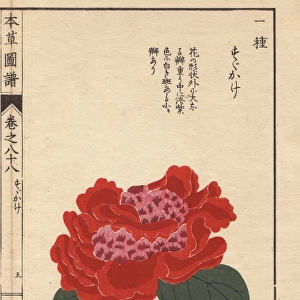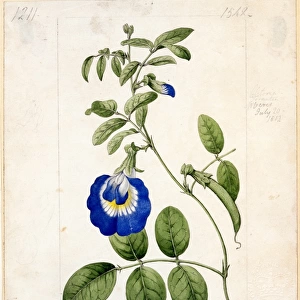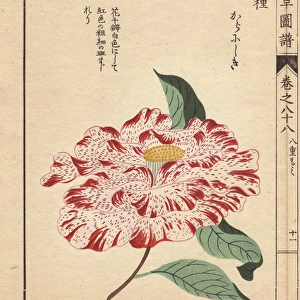Camellia japonica L. camellia
![]()

Wall Art and Photo Gifts from Mary Evans Picture Library
Camellia japonica L. camellia
Type specimens of plants named by Carl Linnaeus (1707-1778). From Amoenitatum exoticarum politico (1712) by Engelbert Kaempfer
Mary Evans Picture Library makes available wonderful images created for people to enjoy over the centuries
Media ID 8594033
© Mary Evans Picture Library 2015 - https://copyrighthub.org/s0/hub1/creation/maryevans/MaryEvansPictureID/10712920
1707 1778 17th Century 18th Century Asterid Camellia Camellia Japonica Camellieae Carl Carl Linnaeus Common Camellia Engelbert Ericales Eudicot Linnaean Linnaeus Theaceae Angiospermae Dicot Dicotyledon Magnoliophyta
EDITORS COMMENTS
This exquisite 18th century illustration showcases the type specimen of Camellia japonica L., commonly known as the Common Camellia or Japanese Camellia. The illustration is taken from Engelbert Kaempfer's Amoenitatum exoticarum politico, published in 1712. Kaempfer, a German botanist and physician, traveled extensively in Asia and the Middle East, collecting and documenting a vast array of plants, including this magnificent Camellia japonica. The illustration was later used by Carl Linnaeus, the father of modern taxonomy, in his groundbreaking work, Species Plantarum, published between 1753 and 1762. Linnaeus named the Camellia japonica as a new species, placing it within the family Theaceae, order Ericales, class Magnoliopsida, and division Magnoliophyta. The plant is an angiosperm, a type of seed-producing flowering plant, and a eudicot, meaning it has two embryonic seed leaves. The Camellia japonica is a beloved ornamental plant, prized for its beautiful flowers. The plant produces large, glossy, evergreen leaves and elegant, often fragrant, flowers in various shades of pink, red, white, and yellow. The flowers typically bloom in late winter or early spring, making them a popular choice for gardens in temperate regions. This illustration provides a fascinating glimpse into the world of 18th century botany, showcasing the meticulous attention to detail and scientific rigor that characterized the work of Kaempfer and Linnaeus. It also highlights the importance of exploration and documentation in the development of modern taxonomy and our understanding of the natural world.
MADE IN THE USA
Safe Shipping with 30 Day Money Back Guarantee
FREE PERSONALISATION*
We are proud to offer a range of customisation features including Personalised Captions, Color Filters and Picture Zoom Tools
SECURE PAYMENTS
We happily accept a wide range of payment options so you can pay for the things you need in the way that is most convenient for you
* Options may vary by product and licensing agreement. Zoomed Pictures can be adjusted in the Cart.








